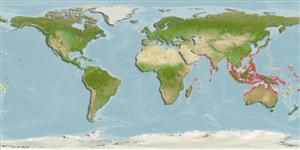Common names from other countries
Environment: milieu / climate zone / depth range / distribution range
Ecologie
marien; zoet water; brak water demersaal; amfidroom (Ref. 51243); diepte 0 - 5 m (Ref. 90102). Tropical; 20°C - 28°C (Ref. 13371); 35°N - 33°S, 48°E - 171°W
Indo-Pacific: Kuwait to Fiji, north to southern Japan, south to New Caledonia. Reported from Samoa (Ref. 9710), Tonga (Ref. 53797), and the Society Islands (Ref. 2847).
Lengte bij maturiteit / Grootte / Gewicht / Leeftijd
Maturity: Lm ?, range 14 - ? cm
Max length : 45.0 cm TL mannelijk / geslacht onbekend; (Ref. 108711); common length : 20.0 cm TL mannelijk / geslacht onbekend; (Ref. 3489)
Dorsale stekels (totaal) : 10 - 11; Dorsale zachte stralen (totaal) : 16 - 18; Anale stekels: 4; Anale zachte stralen: 13 - 15. Ground colour greenish. Juveniles with a few large roundish blotches, about size of eye, or with about 5 or 6 broad, dark, vertical bars. In large adults, spots may be faint and restricted to dorsal part of flanks. Body quadrangular, strongly compressed. Dorsal head profile steep. Eye moderately large, its diameter somewhat smaller than snout length. Snout rounded. Mouth small, horizontal, not protractile. Teeth villiform, in several rows on jaws (ref 43044).
Inhabit harbors, natural embayments, brackish estuaries and the lower reaches of freshwater streams, frequently occurring among mangroves. Feed on worms, crustaceans, insects and plant matter (Ref. 7020, 44894, 48637). The dorsal, anal and pelvic spines are believed by Philippine fishers to be venomous and capable of inflicting wounds (Ref. 6565). Used in Chinese medicine (Ref. 12166). In Hong Kong live fish markets (Ref. 27253). Marketed as fresh (Ref. 12693).
Multiple spawner (Ref. 102820).
Allen, G.R., 1984. Scatophagidae. In W. Fischer and G. Bianchi (eds.) FAO species identification sheets for fishery purposes. Western Indian Ocean (Fishing Area 51). volume 4. [var. pag.]. FAO, Rome. (Ref. 3489)
Status op de Rode Lijst van het IUCN (Ref. 130435)
CITES (Ref. 128078)
Not Evaluated
Gebruik door de mens
Visserij: van minder commercieel belang; Aquacultuur: commercieel; Aquarium: Commercieel
Tools
Speciale rapporten
Download XML
Internetbronnen
Estimates based on models
Preferred temperature (Ref.
115969): 25.4 - 29.3, mean 28.6 (based on 2701 cells).
Fylogenetische diversiteitsindex (Ref.
82804): PD
50 = 0.8125 [Uniqueness, from 0.5 = low to 2.0 = high].
Bayesian length-weight: a=0.03236 (0.02371 - 0.04416), b=2.92 (2.83 - 3.01), in cm Total Length, based on LWR estimates for this species (Ref.
93245).
Trofisch niveau (Ref.
69278): 3.0 ±0.35 se; based on food items.
Weerstandsvermogen (Ref.
120179): Hoog, minimale populatieverdubbelingstijd minder dan 15 maanden (K=0.97; tm=1; Fec=486,500).
Fishing Vulnerability (Ref.
59153): Low vulnerability (20 of 100).
